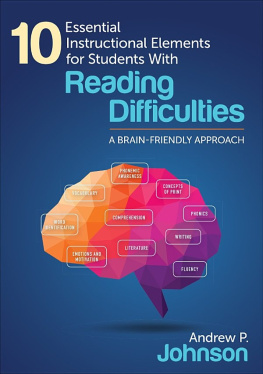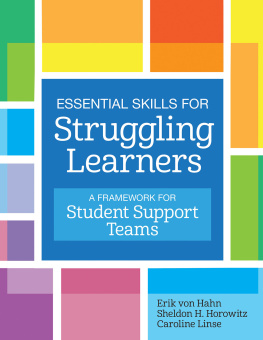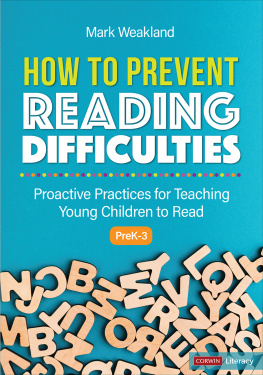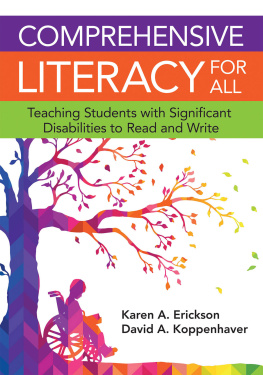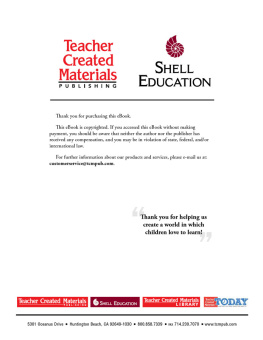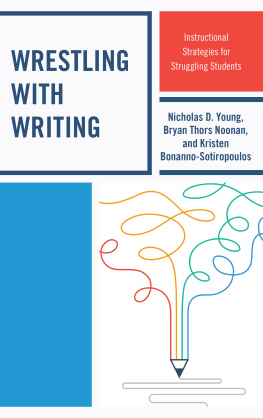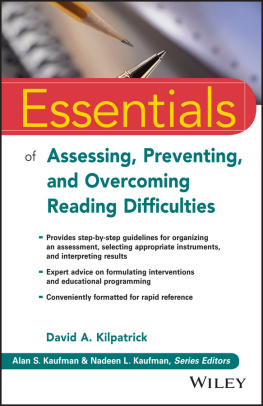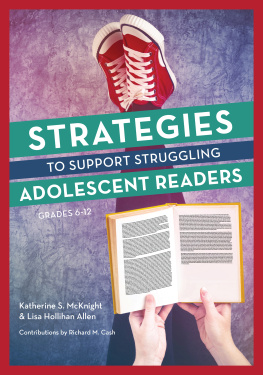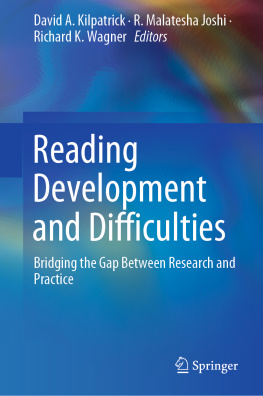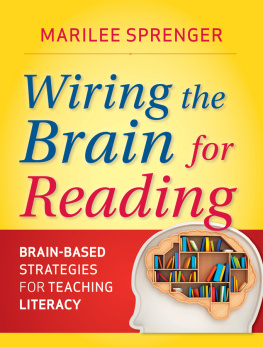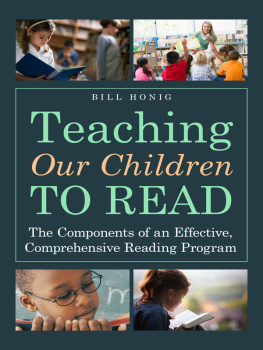10 Essential Instructional Elements for Students With Reading Difficulties
I would like to dedicate this book to my older brother, Dave Johnson, of Wausau, Wisconsin. He is the epitome of what an older brother should be.
10 Essential Instructional Elements for Students With Reading Difficulties
A Brain-Friendly Approach
FOR INFORMATION:
Corwin
A SAGE Company
2455 Teller Road
Thousand Oaks, California 91320
(800) 233-9936
www.corwin.com
SAGE Publications Ltd.
1 Olivers Yard
55 City Road
London EC1Y 1SP
United Kingdom
SAGE Publications India Pvt. Ltd.
B 1/I 1 Mohan Cooperative Industrial Area
Mathura Road, New Delhi 110 044
India
SAGE Publications Asia-Pacific Pte. Ltd.
3 Church Street
#10-04 Samsung Hub
Singapore 049483
Copyright 2016 by Corwin
All rights reserved. When forms and sample documents are included, their use is authorized only by educators, local school sites, and/or noncommercial or nonprofit entities that have purchased the book. Except for that usage, no part of this book may be reproduced or utilized in any form or by any means, electronic or mechanical, including photocopying, recording, or by any information storage and retrieval system, without permission in writing from the publisher.
All trademarks depicted within this book, including trademarks appearing as part of a screenshot, figure, or other image, are included solely for the purpose of illustration and are the property of their respective holders. The use of the trademarks in no way indicates any relationship with, or endorsement by, the holders of said trademarks.
Printed in the United States of America
ISBN 978-1-4833-7377-5
This book is printed on acid-free paper.
Senior Acquisitions Editor: Jessica Allan
Senior Associate Editor: Kimberly Greenberg
Editorial Assistants: Cesar Reyes and Katie Crilley
Production Editor: Melanie Birdsall
Copy Editor: Grace Kluck
Typesetter: C&M Digitals (P) Ltd.
Proofreader: Sally Jaskold
Indexer: Amy Murphy
Cover Designer: Scott Van Atta
Marketing Manager: Jill Margulies
Acknowledgments
Corwin gratefully acknowledges the contributions of the following reviewers:
- Dolores M. Hennessy
- Reading Specialist
- Hill and Plain School
- New Milford, CT
- Natalie S. McAvoy
- Reading Specialist/Interventionist
- Elkhorn Area School District
- Elkhorn, WI
- Jeannie Thorp
- Special Education Teacher
- La Pine Elementary School
- La Pine, OR
- Joan Whoolery
- Reading Specialist
- Fairfax County Public Schools
- Alexandria, VA
About the Author
Dr. Andrew P. Johnsonwas a 1976 graduate of Grantsburg High School in Grantsburg, Wisconsin. He attended the University of Wisconsin, River Falls, where he graduated with a BS degree in music and speech-communication. After earning his elementary teaching licensure, he taught second grade in River Falls, Wisconsin, from 1983 to 1986. He went on to teach in elementary schools in the Twin Cities area and also spent three years working in the Grantsburg School District as a fifth-grade teacher and the Gifted Education coordinator.
He earned his PhD in literacy education from the University of Minnesota in 1997. He is currently working at Minnesota State University, Mankato, as a professor of literacy in the Department of Special Education where he specializes in literacy instruction for students with reading difficulties. He is the author of 10 books and numerous academic articles related to literacy, learning, teacher development, and the human condition.
He lives in North Mankato with his wife, Dr. Nancy Fitzsimons, and his dogs Mickey and Emmet.
Introduction
Context
In our society in this age one must be able to read in order to reach ones full potential. Not only do you need to know how to read, but you also must be able to do so efficiently and effectively. According to the National Institute of Literacy (part of the US Department of Education), 14% of US adults (or about 32 million) cant read, and 21% of US adults read below a fifth-grade level. This greatly impacts their ability to earn a living wage and adequately provide for themselves or a family.
Currently there are about 74 million children under the age of 18 living in the United States. The National Institute of Child Health and Human Development (NICHD) estimates that approximately 20% of them have trouble learning to read. This would be about 14 million children. Of these, 3% to 5% have significant reading difficulties (a severe reading disability). This would be between 2.2 and 3.7 million children. But even if one student was struggling to read, that would be too many, especially if that student was your own child. These students are twice as likely to drop out of high school when compared to their peers. As a result, they are more apt to be unemployed, underemployed, and incarcerated. This means they are far less able to contribute to society, provide for their families, spend money in our economy, and pay taxes. Thus, making sure all children learn to read is more than an educational issue; its a social justice issue.
Code First or Meaning First
There are two basic theoretical perspectives related to reading instruction. These two perspectives used to be identified as phonics and whole language. Some may remember the reading wars of the late 80s and early 90s that pitted phonics against whole language. However, these terms are outdated and inaccurate today. Most teachers who identify themselves as whole language teachers use very explicit phonics instruction in their classrooms. In the same way, most teachers who advocate a phonics-first approach also strive to get students reading whole, complete, meaningful texts to the greatest extent possible. It is more accurate to say that differing theoretical perspectives are the following: a code-first approach based on a bottom-up model that has its basis in behavioral learning theory and a meaning-first approach based on an interactive model that has its basis in constructivism or cognitive learning theory.
Code First
The code-first approach to reading instruction places initial emphasis on decoding. Letter-identification skills of increasing complexity are taught in a specific order (scope and sequence) until students have sufficient command of phonological processes. This approach has been successfully used with many generations of students (including me). Lower-level letter sounds and other reading subskills are taught so that students will be able to engage in higher-level acts of comprehending whole, meaningful text. This reflects a bottom-up or phonological model of reading in which the processing of text is seen to move in a single direction, from letter sounds to words to meaning in part-to-whole fashion. Reading here is equated with sounding out words. In 1983, when I began teaching second grade in River Falls, Wisconsin, I could not imagine that there could possibly be any other way to teach students how to read.

